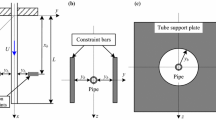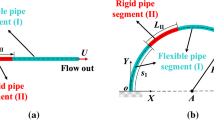Abstract
Theoretical modeling and dynamic analysis of cantilevered pipes conveying fluid are presented with particular attention to geometric nonlinearities in the case of large-amplitude oscillations. To derive a new version of nonlinear equation of motion, the rotation angle of the centerline of the pipe is utilized as the generalized coordinate to describe the motion of the pipe. By using variational operations on energies of the pipe system with respect to either lateral displacement or rotation angle of the centerline, two kinds of new equations of motion of the cantilever are derived first based on Hamilton’s principle. It is interesting that these two governing equations are geometrically exact, different-looking but essentially equivalent. With the aid of Taylor expansion, one of the newly developed equations of motion can be degenerated into previous Taylor-expansion-based governing equation expressed in the form of lateral displacement. Then, the proposed new equation of motion is linearized to determine the stability of the cantilevered pipe system. Finally, nonlinear analyses are conducted based on the current geometrically exact model. It is shown that the cantilevered pipe would undergo limit-cycle oscillation after flutter instability is induced by the internal fluid flow. As expected, quantitative agreement between geometrically exact model and Taylor-expansion-based model can be achieved when the oscillation amplitude of the pipe is relatively small. However, remarkable difference between the results of oscillation amplitudes predicted using these two models would occur for large-amplitude oscillations. The main reason is that in the Taylor-expansion-based model, high-order geometric nonlinearities have been neglected when applying the Taylor expansion, thus yielding some deviation when large-amplitude oscillations are generated. Consequently, the proposed new geometrically exact equation of motion is more reliable for large-amplitude oscillations of cantilevered pipes conveying fluid.











Similar content being viewed by others
References
Kumar, K.A., Sugunamma, V., Sandeep, N., Reddy, J.V.R.: Numerical examination of MHD nonlinear radiative slip motion of non-newtonian fluid across a stretching sheet in the presence of a porous medium. Heat Transf. Res. 50(12), 1163–1181 (2019)
Kumar, K.A., Sugunamma, V., Sandeep, N.: Numerical exploration of MHD radiative micropolar liquid flow driven by stretching sheet with primary slip: a comparative study. J. Non-Equilib. Thermodyn. 44(2), 101–122 (2019)
Kumar, K.A., Reddy, J.V.R., Sugunamma, V., Sandeep, N.: MHD flow of chemically reacting Williamson fluid over a curved/flat surface with variable heat source/sink. Int. J. Fluid Mech. Res. (2019) (Forthcoming Article)
Kumar, K.A., Reddy, J.V.R., Sugunamma, V., Sandeep, N.: Simultaneous solutions for MHD flow of Williamson fluid over a curved sheet with nonuniform heat source/sink. Heat Transf. Res. 50(6), 581–603 (2019)
Kumar, K.A., Sugunamma, V., Sandeep, N.: Impact of non-linear radiation on MHD non-aligned stagnation point flow of micropolar fluid over a convective surface. J. Non-Equilib. Thermodyn. 43(4), 327–345 (2018)
Herrmann, G., Nemat-Nasser, S.: Instability modes of cantilevered bars induced by fluid flow through attached pipes. Int. J. Solids Struct. 3, 39–52 (1967)
Païdoussis, M.P.: Dynamics of tubular cantilevers conveying fluid. J. Mech. Eng. Sci. 12, 85–103 (1970)
Benjamin, T.B.: Dynamics of a system of articulated pipes conveying fluid. II. Experiments. Proc. R. Soc. Lond. A 261, 487–499 (1961)
Gregory, R.W., Païdoussis, M.P.: Unstable oscillation of tubular cantilevers conveying fluid. II. Experiments. Proc. R. Soc. Lond. A 293, 528–542 (1966)
Benjamin, T.B.: Dynamics of a system of articulated pipes conveying fluid. I. Theory. Proc. R. Soc. Lond. A 261, 457–486 (1961)
Gregory, R.W., Païdoussis, M.P.: Unstable oscillation of tubular cantilevers conveying fluid. I. Theory. Proc. R. Soc. Lond. A 293, 512–527 (1966)
Zhang, Y.L., Chen, L.Q.: External and internal resonances of the pipe conveying fluid in the supercritical regime. J. Sound Vib. 332(9), 2318–2337 (2013)
Ding, H., Ji, J.C., Chen, L.Q.: Nonlinear vibration isolation for fluid-conveying pipes using quasi-zero stiffness characteristics. Mech. Syst. Signal. Pr. 121, 675–688 (2019)
Zhang, Y.L., Chen, L.Q.: Internal resonance of pipes conveying fluid in the supercritical regime. Nonlinear Dyn. 67(2), 1505–1514 (2012)
Païdoussis, M.P., Issid, N.T.: Dynamic stability of pipes conveying fluid. J. Sound Vib. 33, 267–294 (1974)
Païdoussis, M.P., Issid, N.T.: Experiments on parametric resonance of pipes containing pulsatile flow. J. Appl. Mech. 43, 198–202 (1976)
Païdoussis, M.P., Sundararajan, C.: Parametric and combination resonances of a pipe conveying pulsating fluid. J. Appl. Mech. 42, 780–784 (1975)
Wang, Y., Wang, L., Ni, Q., et al.: Non-planar responses of cantilevered pipes conveying fluid with intermediate motion constraints. Nonlinear Dyn. 93(2), 505–524 (2018)
Rong, B., Lu, K., Rui, X.T., et al.: Nonlinear dynamics analysis of pipe conveying fluid by Riccati absolute nodal coordinate transfer matrix method. Nonlinear Dyn. 92(2), 699–708 (2018)
Liu, Z.Y., Wang, L., Sun, X.P.: Nonlinear forced vibration of cantilevered pipes conveying fluid. Acta Mech. Solida Sin. 31(1), 32–50 (2018)
Tang, Y., Yang, T., Fang, B.: Fractional dynamics of fluid-conveying pipes made of polymer-like materials. Acta Mech. Solida Sin. 31(2), 243–258 (2018)
Païdoussis, M.P.: Fluid-Structure Interactions: Slender Structures and Axial Flow. Academic Press, London (1998)
Holmes, P.J.: Bifurcations to divergence and flutter in flow-induced oscillations: a finite-dimensional analysis. J. Sound Vib. 53, 471–503 (1977)
Cheg, E., Dowell, E.H.: A theoretical analysis of nonlinear effects on the flutter and divergence of a tube conveying fluid. Flow-Induced Vibrations, pp. 65–81. Wiley, New York (1979)
Lundgren, T.S., Sethna, P.R., Bajaj, A.K.: Stability boundaries for flow induced motions of tubes with an inclined terminal nozzle. J. Sound Vib. 64, 553–571 (1979)
Bajaj, A.K.: Bifurcation to periodic solutions in rotationally symmetric discrete mechanical systems. Ph.D. Thesis, University of Minnesota (1981)
Rousselet, J., Herrmann, G.: Dynamic behaviour of continuous cantilevered pipes conveying fluid near critical velocities. J. Appl. Mech. 48, 943–947 (1981)
Holmes, P.J.: Pipes supported at both ends cannot flutter. J. Appl. Mech. 45, 619–622 (1978)
Semler, C., Li, G.X., Païdoussis, M.P.: The nonlinear equations of motion of pipes conveying fluid. J. Sound Vib. 169, 577–599 (1994)
Païdoussis, M.P., Semler, C.: Nonlinear dynamics of a fluid-conveying cantilevered pipe with an intermediate spring support. J. Fluids Struct. 7(3), 269–298 (1993)
Païdoussis, M.P., Moon, F.C.: Nonlinear and chaotic fluidelastic vibrations of a flexible pipe conveying fluid. J. Fluids Struct. 2, 567–591 (1988)
Païdoussis, M.P., Semler, C.: Non-linear dynamics of a fluid-conveying cantilevered pipe with a small mass attached at the free end. Int. J. Nonlinear Mech. 33(1), 15–32 (1998)
Tang, D.M., Dowell, D.H.: Chaotic oscillations of a cantilevered pipe conveying fluid. J. Fluids Struct. 2(3), 263–283 (1998)
Païdoussis, M.P., Semler, C.: Nonlinear and chaotic oscillations of a constrained cantilevered pipe conveying fluid: a full nonlinear analysis. Nonlinear Dyn. 4, 655–670 (1993)
Antman, S.S.: Nonlinear Problems of Elasticity. Springer, New York (2005)
Lacarbonara, W.: Nonlinear Structural Mechanics: Theory, Dynamical Phenomena and Modeling. Springer, New York (2013)
Farokhi, H., Ghayesh, M.H.: Extremely large oscillations of cantilevers subject to motion constraints. J. Appl. Mech. 86, 031001 (2019)
Stoker, J.J.: Nonlinear Elasticity. Gordon and Breach Science Publishers, New York (1968)
Acknowledgements
The authors would like to gratefully acknowledge the financial support of the National Natural Science Foundation of China (Nos. 11622216, 11672115) to this work.
Author information
Authors and Affiliations
Corresponding author
Ethics declarations
Conflict of interest
The authors have no conflict of interest.
Ethical standard
All procedures performed in studies involving human participants were in accordance with the ethical standards of the institutional and/or national research committee and with the 1964 Helsinki Declaration and its later amendments or comparable ethical standards.
Human and animal rights
This article does not contain any studies with animals performed by any of the authors.
Informed consent
Informed consent was obtained from all individual participants included in the study.
Additional information
Publisher's Note
Springer Nature remains neutral with regard to jurisdictional claims in published maps and institutional affiliations.
Appendix
Appendix
As can be seen from Eqs. (7)–(9) and (11), the variations of various terms can be expressed by three possible virtual displacements, including \(\delta u\), \(\delta w\) and \(\delta \theta \). In order to derive the governing equation and boundary conditions of this dynamical system, expressing these variations in terms of one single virtual displacement is necessary. In this part, the various variations will be, respectively, expressed by \(\delta w\) and \(\delta \theta \) for the purpose of deriving the governing equations in Sects. 2.1 and 2.2.
The relationships of \(\delta u\), \(\delta w\) and \(\delta \theta \) can be obtained via Eqs. (2) and (3). The variational operations on Eqs. (2) and (3) lead to
To maintain consistency with Sect. 2.1, we will firstly utilize \(\delta w\) as the virtual displacement for derivation purpose. The substitution of Eq. (48a) into Eq. (7) generates another form of the first term in Eq. (7) as
with the aid of the following important equation given by Semler et al. [29]
By using Eq. (48a) and Eq. (8), the variation of the strain energy can be rewritten as
The similar operation on Eq. (9) leads to
The second term of the right-hand side of Eq. (11) can be further written as
The variations expressed by the virtual displacement \(\delta \theta \) are called for the derivation in Sect. 2.2. With the aid of Eq. (50), the substitution of Eq. (48b) into Eq. (7) yields another form of the first term in Eq. (7), i.e.,
The second term in the variation of the kinetic energy (see Eq. (7)) can be rewritten as
An analogous variational procedure on the gravitational energy leads to
Furthermore, the last term in Eq. (11) may be given by
Rights and permissions
About this article
Cite this article
Chen, W., Dai, H., Jia, Q. et al. Geometrically exact equation of motion for large-amplitude oscillation of cantilevered pipe conveying fluid. Nonlinear Dyn 98, 2097–2114 (2019). https://doi.org/10.1007/s11071-019-05310-0
Received:
Accepted:
Published:
Issue Date:
DOI: https://doi.org/10.1007/s11071-019-05310-0




